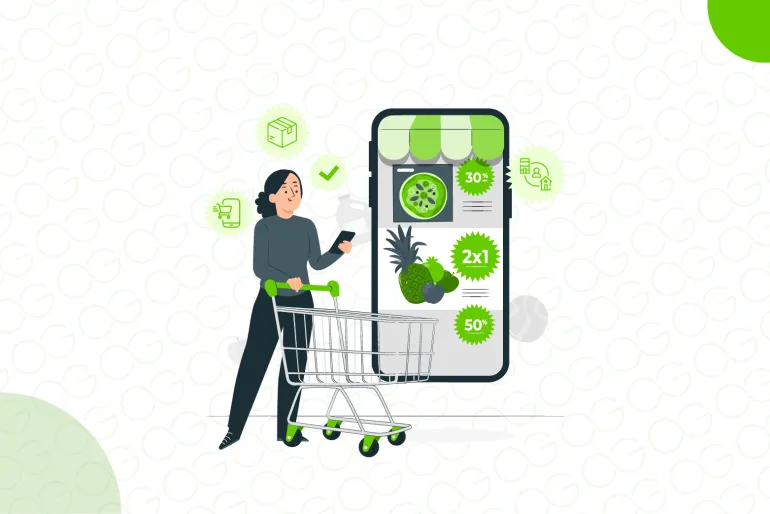Post-COVID Options for Indian Grocery Retail
The COVID-19 pandemic has fundamentally altered the retail landscape, especially in India. Although the country has largely overcome the immediate impact of lockdowns, the effects on consumer behaviour and retail dynamics are here to stay. One major consequence of the pandemic is the accelerated shift toward eCommerce, even though India's eCommerce penetration remains relatively low compared to countries like the US and China. However, the potential for growth in online retail is enormous, as demonstrated by record-breaking festival shopping in India during the pandemic.
While major players like Amazon and BigBasket struggled to meet the surging demand for online grocery orders during the lockdown, smaller retailers and local kirana stores saw a unique opportunity to pivot towards online retailing. According to a report in Mint, over 70% of kirana stores are now considering shifting to online retailing as a long-term growth strategy. This shift is driven not only by the necessity brought on by the pandemic but also by the realisation that eCommerce offers promising benefits and growth opportunities.
With that in mind, this blog explores the post-COVID options available to Indian grocery retailers, particularly small and medium-sized businesses, as they navigate the challenges and opportunities of the evolving retail landscape.

Explore Ginesys retail solutions designed to help Indian grocery retailers succeed
Window of Opportunity for Small and Medium Retailers
The pandemic highlighted one critical weakness in online retail: its inability to scale effectively during demand surges. During lockdowns, eCommerce giants like BigBasket and Amazon struggled to keep up, with deliveries delayed by as much as a week. This shortfall created an opportunity for smaller retailers, particularly local kirana stores, to step in and fill the gap. While these small stores traditionally focused on in-person shopping, many are now exploring ways to incorporate online sales into their business model.
As the Indian retail industry begins to recover from the pandemic, the window of opportunity remains open for small and medium retailers. These businesses can adopt a variety of strategies to take advantage of the growing demand for online shopping while maintaining their traditional customer base. Let's explore some of these approaches:
1. Dark Stores Approach
One of the most promising strategies for small grocery retailers is the dark store model. A dark store is essentially a traditional retail store that has been repurposed to function exclusively as a fulfilment centre for online orders. This concept, akin to cloud kitchens in the food industry, allows businesses to focus solely on processing and delivering online orders without the need for a physical storefront. Dark stores have gained popularity worldwide, particularly in the wake of the pandemic.
In India, dark stores offer a compelling solution for grocery retailers looking to meet the growing demand for online shopping. By converting a portion of their existing retail space into a fulfilment centre, retailers can efficiently manage online orders and offer scheduled pickups or deliveries. The dark store model also eliminates the overhead costs associated with operating a traditional storefront, such as rent, utilities, and staffing.
While this approach was initially limited to grocery stores, it has since expanded to other retail sectors, including clothing, footwear, jewellery, and FMCG (Fast-Moving Consumer Goods). As online retail continues to grow, dark stores represent a scalable and efficient way for retailers to meet customer demand while minimising operational costs.
2. The Hybrid Approach
For retailers who want to maintain their physical storefront while also catering to online shoppers, the hybrid approach offers the best of both worlds. In this model, retailers allocate a portion of their brick-and-mortar store to serve as a fulfilment centre for online orders, while the rest of the space remains dedicated to traditional in-store shopping.
This approach allows retailers to retain the advantages of in-person shopping—such as customer experience and the ability to interact directly with products—while also tapping into the growing online market. Shoppers who prefer the tactile experience of visiting a store can still do so, while those who value convenience and contactless transactions can place their orders online and either pick them up in-store or have them delivered.
For grocery retailers, the hybrid model can be particularly effective. By leveraging a portion of their store for fulfilment, retailers can offer faster delivery or pickup options for nearby customers while maintaining the customer loyalty built through personal service and a physical presence in the community.

Get expert guidance on building your hybrid or dark store model
3. The Tie-Up Approach
Partnering with established eCommerce platforms is another viable option for grocery retailers looking to expand their online presence. In the tie-up approach, local retailers collaborate with major eCommerce platforms like Amazon, BigBasket, or Grofers to sell their products online.
By piggybacking on the established infrastructure of these eCommerce giants, retailers can reach a much larger customer base without the need for significant upfront investment in technology or logistics. This approach allows smaller retailers to compete on a larger stage while still maintaining their local presence.
For retailers in other sectors, such as clothing or electronics, the tie-up approach can be equally beneficial. Many large eCommerce platforms offer seller partnerships that provide access to tools for managing inventory, processing payments, and handling deliveries. This reduces the complexity of launching an independent online store and allows businesses to focus on what they do best—providing quality products to their customers.

4. The Go Solo Approach
For retailers who are confident in their ability to navigate the challenges of eCommerce independently, the go solo approach involves launching their own online store. With the rise of user-friendly eCommerce platforms like Shopify, StoreHippo, and Magento, setting up an online store has never been easier.
However, while building an eCommerce site may be straightforward, driving traffic to the site and converting visitors into customers requires a well-thought-out strategy. Retailers opting for the go solo approach need to be prepared to invest in customer acquisition through digital marketing, SEO, and social media. Additionally, managing an online store requires robust technology, such as cloud-based ERP (Enterprise Resource Planning) and inventory management systems, to ensure smooth operations and order fulfilment.
The go solo approach is ideal for retailers who are willing to invest the time and resources needed to build a brand online. For example, niche grocery retailers that specialise in organic or gourmet products may find success by creating an online presence that appeals to a specific customer segment.
5. The Protect the Legacy Approach
For some retailers, especially traditional brick-and-mortar stores, the focus may be less on building an online presence and more on enhancing the in-store shopping experience. The protect the legacy approach involves upgrading the operations of physical stores to offer modern conveniences without fully transitioning to eCommerce.
One of the primary reasons many consumers continue to shop in-store, despite the rise of online shopping, is the experience. In-person shopping allows customers to see, touch, and compare products before making a purchase, which can be especially important for grocery shopping. Retailers can enhance this experience by offering services such as:
- Gift vouchers and loyalty programs to reward regular customers.
- Paperless billing for a more convenient checkout process.
- Endless aisles, where customers can order out-of-stock items in-store for home delivery.
- Click-and-collect services, allowing customers to shop online and pick up their orders at the store.
By focusing on creating memorable in-store experiences, traditional grocery retailers can continue to thrive in an increasingly digital world with the help of grocery retail software. Upgrading their technology and customer service offerings ensures that they remain relevant to both long-time patrons and new customers who value convenience.

Learn how Ginesys can help your grocery business thrive in a post-COVID world
The shift towards online retail is not a temporary trend—it is a permanent evolution of the retail landscape. While the pandemic accelerated this transformation, the reality is that consumers are now more comfortable than ever with the convenience and flexibility that online shopping offers. As a result, retailers—both large and small—must adapt to this new reality to remain competitive.
For Indian grocery retailers, the post-COVID era presents a unique opportunity to embrace online retail while leveraging the strengths of their traditional business models. Whether through dark stores, hybrid models, partnerships with eCommerce giants, or independent online platforms, the options are plentiful. Retailers who adapt quickly and strategically to these changes will be well-positioned to thrive in the years to come.
Need assistance managing your retail stores?
Get in touch with Ginesys and explore how our retail software solutions can help you navigate the challenges of both online and offline retail.

